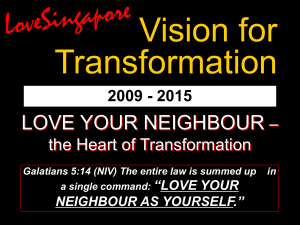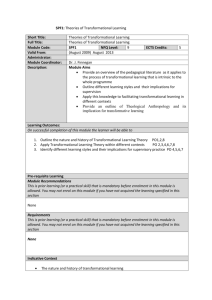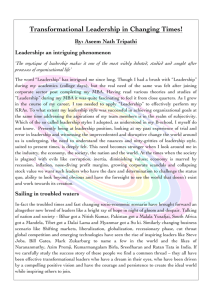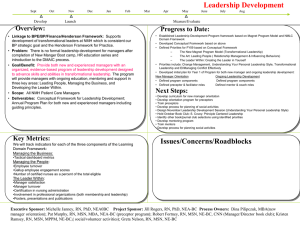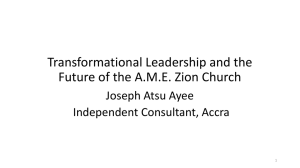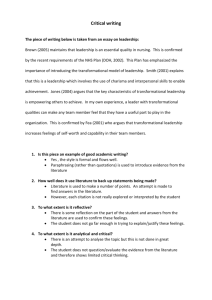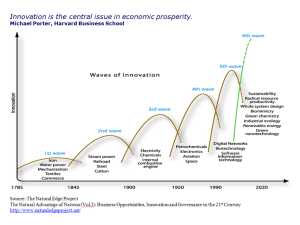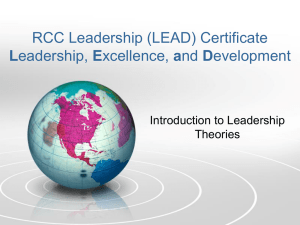Dr. Patrick Breard - The United Nations Public Service Forum 2013
advertisement
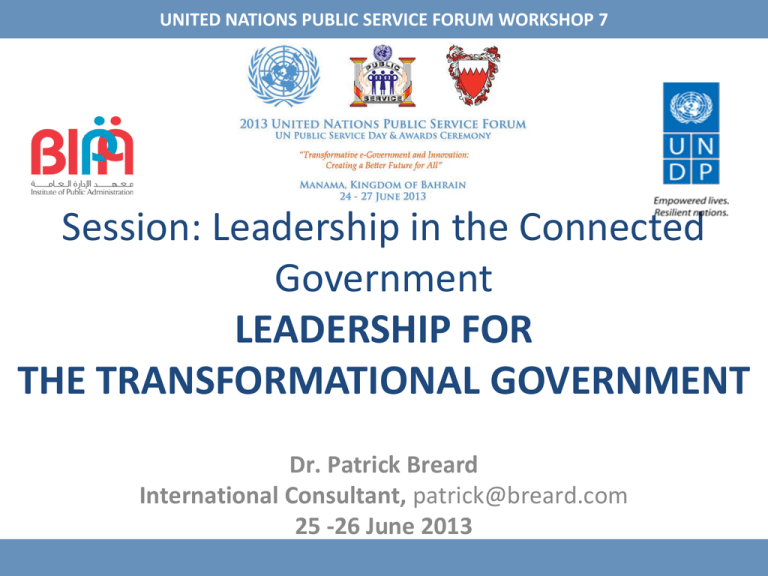
UNITED NATIONS PUBLIC SERVICE FORUM WORKSHOP 7 Session: Leadership in the Connected Government LEADERSHIP FOR THE TRANSFORMATIONAL GOVERNMENT Dr. Patrick Breard International Consultant, patrick@breard.com 25 -26 June 2013 Agenda • Introduction & Objectives • Presentation (30 min.) • Group Discussions (45 min.) • Reporting to Plenary (15 min.) • Conclusion LEADERSHIP FOR THE TRANSFORMATIONAL GOVERNMENT The Connected Government Leadership in the Connected Government Connected services: • Governments proactive in requesting information and opinions from the citizens using Web 2.0 and other interactive tools; • E-services and e-solutions cut across departments and ministries; • Information, data and knowledge transferred from government agencies • From a government-centric to a citizen-centric approach with e-Services targeted to citizen groups and segments; • Citizens empowered to be more involved with government activities so as to have a voice in decision-making. Source: UN –E-Government Survey 2012 LEADERSHIP FOR THE TRANSFORMATIONAL GOVERNMENT GCC Outlook GCC E-Government Development Index 2012 1 0.9 0.8 0.7 Bahrain Index Level 0.6 Kuwait Oman 0.5 Qatar Saudi Arabia 0.4 UAE World 0.3 0.2 0.1 0 E-Government Online Services Human Capital Infrastructure E-Participation LEADERSHIP FOR THE TRANSFORMATIONAL GOVERNMENT Sample Tools for e-participation Source: UN –E-Government Survey 2012 Source: UN –E-Government Survey 2012 LEADERSHIP FOR THE TRANSFORMATIONAL GOVERNMENT Connected Projects Uservoice, ideascale Forum, CoP, blogs, twitter Google moderator Crowdfunding Brainstorming solutions Open Discussion prompts Set priorities Collaborative visualization, gamification Social collaboration (blogs, TWs) proposals Identify problems Drafting proposals Resource mobilization Project tasks Systemic Ensure change Buy-in Project flow Collect evidence Crowdsourcing Big Data Analiyze data Data visualization, infographics Induce behavioural change Sustaining Collect feedback Social networks Collaborative action Challenges Scaling Prototypes Project tools Monitor execution Participatory sensing Persuasive technologies. User driven innovation Open data, Real Simple Reporting LEADERSHIP FOR THE TRANSFORMATIONAL GOVERNMENT Case Studies Communities of Practice Social Networks LEADERSHIP FOR THE TRANSFORMATIONAL GOVERNMENT Leadership • Leadership is of paramount importance for system wide knowledge sharing and management • Engagement from leaders is strategic and time bounded, but they need to talk the talk and walk the walk • Consistent messages, persistence over time and recognition of KM achievements and progresses are inspiring and critical o o Communicate the purpose Promote a knowledge-based organization, KM practices and knowledge sharing behaviours “UNDP is now a practice-driven organization committed to delivering high quality capacity building and policy advice in our 6 main practice areas. Making this system work is dependent on knowledge sharing at every level of the organization.” - Mark Malloch Brown, 2002. “UNDP is a global organization. And I believe this is one of our sources of strength and something we have to preserve. Preserve in the sense that the knowledge, the communication, has to be at the global level… Africa should have access to global knowledge and south Asia should participate in that. People in Africa, in Mozambique, should know what is happening in Indonesia, what is happening in Brazil.” - Kemal Dervis, 2005 “We aspire for UNDP to be a world class knowledge-based organization, which generates and disseminates knowledge at all levels, both internally and externally. That knowledge must be explicitly linked to the needs of the programme countries and regions to which we respond.” Helen Clark, 2010 LEADERSHIP FOR THE TRANSFORMATIONAL GOVERNMENT Risks in a Connected Government • Infrastructure • Online Services • Human Capital • E-Participation LEADERSHIP FOR THE TRANSFORMATIONAL GOVERNMENT Leadership Characteristics • Leaders gain the best results by using a combination of leadership styles • Leadership styles are each appropriate for different types of situations • How do Leadership characteristics fit with a Connected Government? Role 1. 2. 3. 4. 5. 6. 7. 8. 9. 10. 11. 12. 13. Style Set a vision Communicate change Inspire and influence Develop capacities Affirm & promote values Drive for results Monitor environment Create cohesiveness Diminish conflicts Delegate authority Encourage innovation Represent the group Evaluate and reward 1. 2. 3. 4. 5. 6. 7. Coercive Authoritative Pacesetting Coach Democratic Affiliative Laissez-faire Skills, Behaviors and Traits 1. 2. 3. 4. 5. 6. 7. 8. 9. 10. 11. 12. 13. Charisma Honesty Credibility Emotional Intelligence Trustfulness Openness to experience Persistence Conscientiousness Sociability Self-confidence Intelligence 14. Integrity Adjustment 15. Acceptance of mistakes Extraversion 16. General self-efficacy LEADERSHIP FOR THE TRANSFORMATIONAL GOVERNMENT Group Work 1. Introductions 2. Volunteer a facilitator & rapporteur 3. Discuss the following questions (45 min.) • Question common to all tables • What are your experiences, success stories, and lessons learned with the Connected Government? One example of Leadership intervention / contribution to a successful e-Government initiative? • Tables specific question A. What are the functions and attributes of successful transformational Leadership in a Connected Government, e.g. in terms of tasks, responsibilities, skills, traits and styles? Does the Connected Government influence the Leadership function? B. What are the opportunities and threats for the Leadership function in the Connected Government? Successful practices to mitigate any threats a Connected Government may put on the Leadership function? 4. Report to plenary (15 min. per table) LEADERSHIP FOR THE TRANSFORMATIONAL GOVERNMENT




